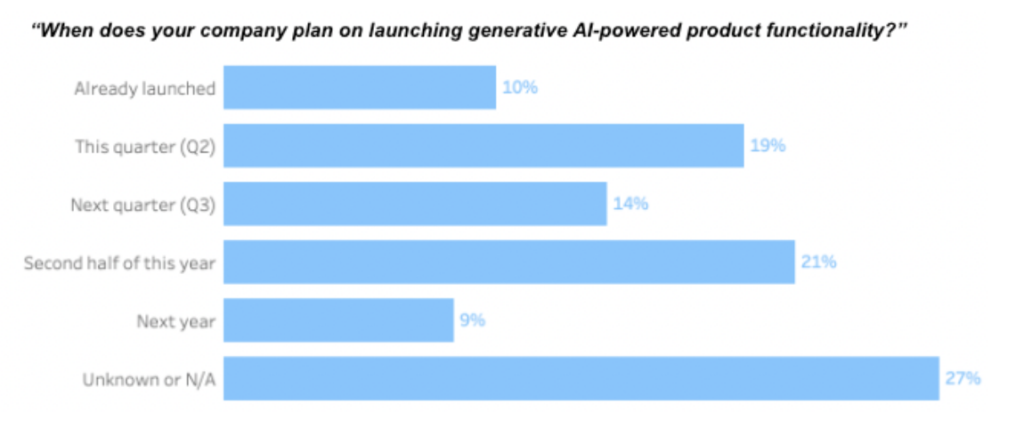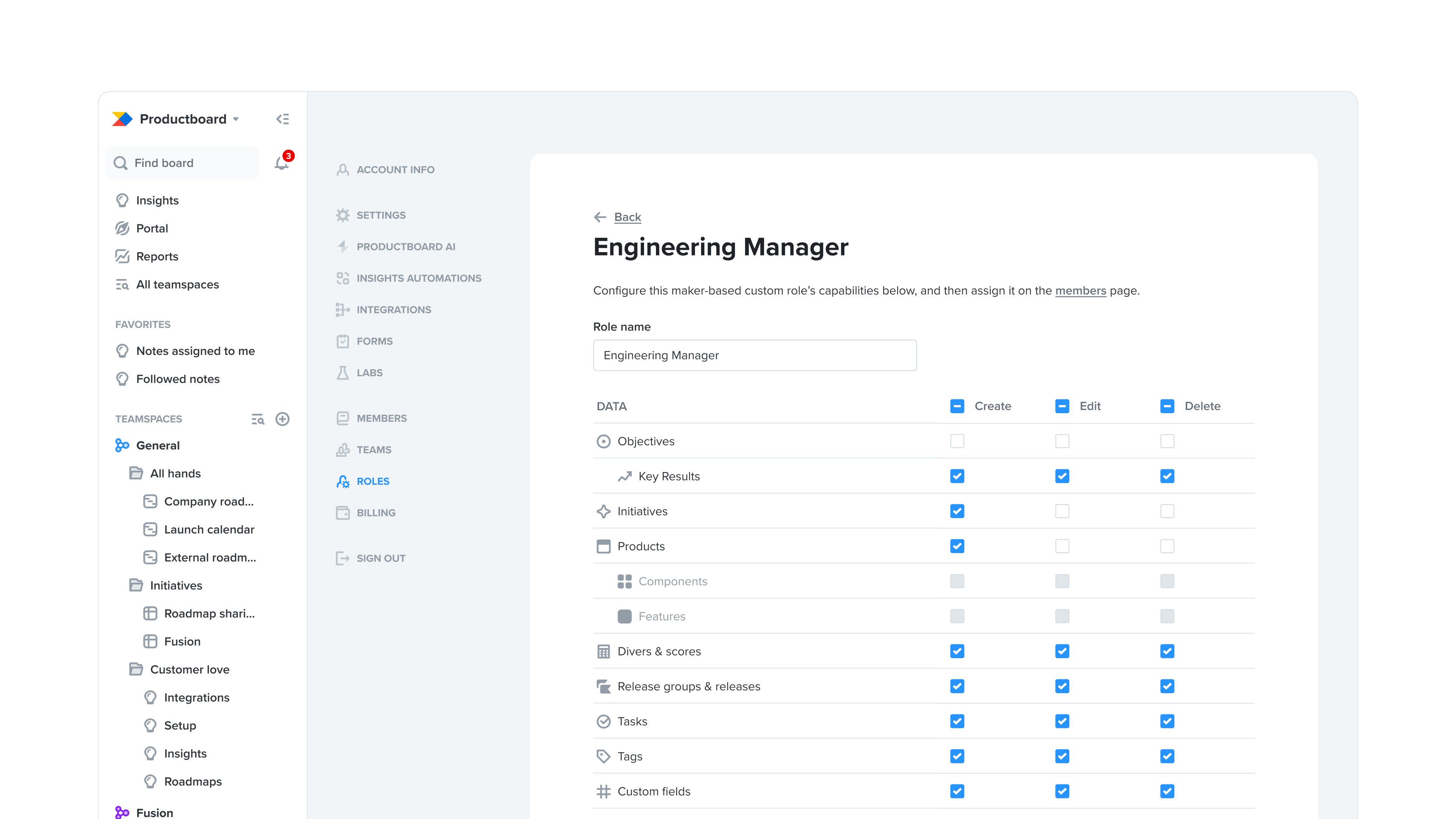90% of VC-Backed Companies Plan to Launch Generative AI in their Products, 64% this Year

Overall, Innovation Ranks #1 in Companies’ R&D Spend Priorities for 2023
ChatGPT brought generative AI into the limelight when it hit 1M users in five days—and the buzz has only increased over time. For software and tech companies, there has been immense pressure to ideate and launch generative AI features or incorporate Chat GPT into their products, and even traditional companies are considering how they can use it to make their company more efficient.
Given the wild ride of the economy, layoffs, the explosion of AI and more, we wanted to see how product and engineering teams were being affected. Our recent AI and R&D survey, launched today, examines just that. The survey provides insights from more than 300 CEOs, Founders, Chief Product and Technology Officers, and VPs of Product from startups to public companies. The survey was conducted mid-April – mid-May this year by gathering respondents from portfolio companies of top VCs including Bessemer, Dragoneer, Kleiner Perkins, plus subscribers to Productboard and the online newsletter of Theory Ventures’ Founder Tomasz Tunguz. 70% of respondents came from software and tech with the remainder coming from a mix of industries including finance, healthcare, manufacturing, education, and retail.
The findings show that:
- 90% of companies are allocating people to work on Generative AI in their products, 64% plan to launch by the end of the year.
- The majority of companies are allocating small teams relative to their size, with startups allocating 1-2, midsize allocating under 5, and the majority of large companies allocating under 10 team members.
- From a broader perspective, while more than 30% of companies cut overall spend this year, more than 80% of companies plan to spend the same or more on R&D, with nearly 50% planning to increase overall investment on R&D.
- For companies that did layoffs this year, R&D headcount was cut less than other departments.
- Companies are prioritizing innovation over spend on core products and technical debt.
These results in summary show that many companies are placing big bets on their product and engineering teams to propel them through this economic downturn and through to leadership on the other side. The pressure on R&D to live up to those expectations and show real ROI has never been higher. Read on for more detail on the data.
Almost Everyone is Allocating Some Staff to Support Generative AI
According to our survey, drawn primarily from many respondents close to the VC world, almost all (90%) of companies are allocating engineers and product people to add generative AI to their products. However, allocations are still on the smaller size relative to overall team sizes, with the majority of early-stage startups allocating under 2 team members, mid-size companies allocating under 5 team members, and largest companies allocating under 10.

Nearly 30% of companies will be hiring new AI team members. 54% of companies are allocating existing team members to generative AI. This may be a factor of low supply of experienced generative AI team members with generative AI being so new.

Release Schedules Are Aggressive
Despite the many priorities and distractions on R&D agendas this year, 10% of respondents have already launched generative AI functionality and 19% are launching this quarter. 64% will launch features by the end of the year.

What does this AI data mean for product teams?
- If you’re not already allocating resources to generative AI, know that your competitors probably are.
- Competition for generative AI resources will be very tight. Training for your existing resources will be critical to supplement outside hires.
- Product strategy and alignment on which additions will really make a difference will be critical to longer-term success. Many people might race to get “something” out the door, but to make a real impact on revenue, they’ll need to listen to customer needs and usage, build strategic product plans, align across the business, and execute effectively.
Broader R&D Data: Many Companies are Cutting Spend but Preserving or Increasing R&D Investments
According to the results of our survey, almost half of larger companies and a third of startups have cut spend overall as a company this year.

But 82% of companies with over $10M in revenue plan to increase or maintain their R&D spend, with the number climbing to 95% for early-stage startups.

Over 28% of the companies surveyed reported layoffs in 2023. Of those that did layoffs, R&D teams were cut much LESS than other departments.

Innovation is the Top R&D Priority
So where is all of that investment going? Across all market segments, Innovation & Differentiation were the most significant investment priorities, followed by core product and technical debt.

Unfortunately, despite having the greatest allocation of resources, the majority of teams didn’t feel that they had enough resources to do what they needed to do this year.

How Big Are R&D Teams?
The distribution of how much a company spends on its R&D varies quite widely based on their product, go-to-market approach, industry, stage, market, and more. Our research shows the following distribution. Unsurprisingly, larger companies’ teams are larger.

But as companies scale, on the whole, they tend to allocate less budget to product and engineering. With product-market fit, they can gradually decrease product spending as costs add up in sales, marketing, and operations.

What does this mean for product teams?
In this tough economy, many companies are cutting overall budgets and headcount. But according to our research, product, and engineering teams are being prioritized as an engine to power companies through this economic downturn. The pressure for results is higher than ever. Given this dynamic, R&D teams should consider three key themes:
- Be sure you’re prioritizing the right product features – According to our past market research, 64% of respondents say that their products and releases aren’t consistently well received. It’s not enough to ship products that you THINK customers will want. You have to KNOW that you are focusing on what will really make an impact on your customers and prospects and drive ROI on your development efforts, including in generative AI.
- Drive alignment on priorities – One of the biggest issues companies face today is a lack of alignment. Priorities by one team aren’t the same for others, especially as companies scale and silos form across the organization. This can lead to a functional mismatch of product components, delays on releases and big misses on hitting expectations. Having a single source of truth system for product development, and a clear roadmap that unites the business, can provide clarity into priorities from the highest level down.
- Execute more effectively – If you’ve set the right priorities and aligned teams across R&D and the business, you still need to DELIVER on the vision. Getting all the right people on the same page as to what exactly needs to be done when, and how, is no small feat. The difference between average and exceptional performance is often in the execution. As Thomas Edison said, “Genius is 1% inspiration and 99% perspiration.”
This difficult economy is a huge drag on many businesses today. But investing in exceptional products, innovation, and efficient execution will give you a better chance of taking the leadership position, today and tomorrow.




